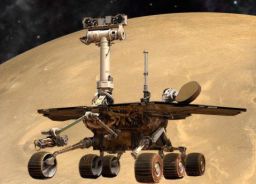A.J.S. Rayl • Jul 31, 2010
Mars Exploration Rovers Update: Spirit Sleeps Soundlessly, Opportunity Turns a Corner
Winter lingers in the southern hemisphere of the Red Planet, but the Sun is beginning to rise higher in the sky and temperatures are slowly rising, signs the Mars Exploration Rovers are heading into spring. While Spirit continued hibernating, Opportunity took in the warmth of the Sun, captured its first dust devil, and picked up the pace in Meridiani Planum on the long journey to Endeavour Crater. Together, the rovers marked six and a half years of exploration.
The sounds of static silence were all that could be heard from Gusev Crater this month were as Spirit snoozed throughout July. “The rover’s status hasn’t changed since last month,” reported Ray Arvidson, deputy principal investigator, of Washington University, St. Louis. “We’re still waiting, with anticipation.”
The low angle of sunlight during the Martian winter months at Gusev Crater limits the amount of ‘fuel’ Spirit can take in through its solar panels, and thus the power it can generate from it. Last March, the rover, unable to get to anorthern slope to angle its solar arrays directly at the Sun, lost power and, as programmed, presumably went into a deep sleep, suspending communications and other activities to use available energy to recharge and heat the two main power batteries, and to keep the mission clock running. The team has not heard from the rover since March 22 of this year.
This last week however, rover engineers at the Jet Propulsion Laboratory (JPL), where Spirit and Opportunity were born and are being managed, began using a paging technique to send wake-up calls just in case the robot field geologist has lost track of time, said John Callas, MER project manager. While the team has been listening daily for a beep from Spirit for a couple of months, there is some concern that the rover’s batteries may have lost so much power that the robot’s mission clock may have stopped, an electronic event known as a mission clock fault.
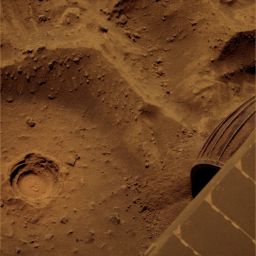 A good omen?
A good omen?This picture, which Spirit took with its Pancam last February, was among the last several batches of images the rover sent down to earth before shutting down and going into hibernation. If you look closely in the circular RAT grind, you'll see an uncanny little sign of luck. As rover aficiando and MER poet Stuart Atkinson,who discovered this, put it: "That has to be a lucky horseshoe in that hole." Time will tell if it really was a good omen of things to come for this devoted and determined rover or just a coincidence. Credit: NASA / JPL-Caltech / Cornell / colorization by S. Atkinson
Since the team is not in communication with Spirit, there is no way of knowing right now whether the rover tripped the mission clock fault or not, “but our most recent models indicate it is possible,” explained Bill Nelson, chief of the rover engineers. If the rover has tripped the mission clock fault, it would -- not knowing the time -- remain asleep until there is enough sunlight on its solar arrays to wake it up, a state called "solar groovy."
In that scenario, once the rover awakens, it is programmed to start a new clock or timer with an alarm set to wake it up every four hours and stay awake for one hour if the Sun is up. During that one awake hour, the rover is to listen for 20 minutes for a signal from Earth, then shut down until the next alarm four hours later. Spirit would not be communicating to Earth, but waiting for Earth to communicate with it.
The team decided not to wait. Calculating July 23rd as the earliest date the rover could be responsive if it has suffered a mission clock fault, the rover engineers went pro-active and began reaching out to Spirit. “Instead of just listening, we are sending commands to the rover to respond back to us with a communications beep,” Callas said. “If the rover is awake and hears us, she will send us that beep."
The latest model notwithstanding, the MER team doesn’t really expect Spirit to respond this soon, Callas admitted, noting that most all bets remain on September, October, or November. That’s the timeframe when mission managers anticipate the batteries will be adequately charged based on models of Mars' weather and its effect on available power. If the rover has tripped the mission-clock fault, that timeframe shifts to October and beyond, he said.
Since the mission has never been down this road before. Neither rover has previously gone into hibernation or tripped a low-power fault or master clock fault, Spirit is pioneering new ground again. The MER team is making sure it’s doing everything possible to communicate and re-orient their rover if need be. “We’re addressing the possibilities,” Callas said.
One possibility, of course, is that Spirit may never respond. During the rovers’ three previous Martian winters, Spirit communicated about once or twice a week with Earth and used its heaters to stay warm while parked on a Sun-facing slope for the winter. As a result, its internal temperatures were maintained above -40 degrees Celsius (which is also -40 degrees F). Since the rover was stuck on flat ground and because its heaters were not powered throughout this winter, the robot likely experienced the coldest internal temperatures yet, estimated around -55 degrees Celsius (-67 degrees Fahrenheit) inside the rover electronic module (REM), or rover ‘body,’ which encases Spirit’s computer or ‘brain’ and other sensitive components.
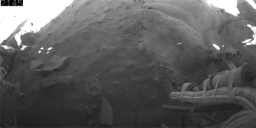 Stopped in her tracks
Stopped in her tracksThis animation shows Spirit's movement in five drives from Sols 2145-2154 (Jan. 14-23, 2010). The rover, which took the images that went into this mini-movie with its rear hazard-avoidance camera about a month before it parked for winter, ws beginning to make progress in extricating itself from a sand path that trapped it since May 2009. The view is toward the south, looking down at the rover's rear wheels. Credit: NASA / JPL-Caltech
“It's never faced this type of severe condition before -- this is unknown territory," stated Doug McCuistion, director of NASA's Mars Exploration Program in Washington D.C., in an official press release issued July 30th. “It will be the miracle from Mars if our beloved rover phones home.”
For these rovers though, miracles have come true and at JPL optimism still rules the rover roost. While the possibility that the rover tripped the mission clock fault has added for some “a layer of pessimism,” as Nelson described it, no one on the team is betting against Spirit, not yet. “There is the risk that Spirit may not recover from hibernation, but the expectation here is that she will,” Callas told the MER Update this week.
“Although our optimism is tempered by a certain amount of reality, we think there is good reason to believe that Spirit has a chance -- these rovers have proven to be pretty robust, there’s no strong reason to believe anything has gone wrong, and we’re hoping for the best knowing there is some rationale for that,” expounded Nelson.
For one thing, Opportunity’s internal temperatures, inside its REM, have increased 10 to 15 degrees since the depths of winter and the assumption is that Spirit’s is likewise warming as well. “It’s not a huge increase, but it is an indication of good things to come,” Nelson suggested.
Nothing, however, comes easy for Spirit. Based on previous Martian winters, the rover team anticipates the increasing haziness in the sky over Spirit that comes with spring will offset the longer daylight and increased sunlight for the next two months. By October, however, the amount of solar energy available to the rover will then increase until the southern Mars summer solstice in March 2011.
"This has been a long winter for Spirit, and a long wait for us," said Steve Squyres, MER principal investigator, of Cornell University. "Even if we never heard from Spirit again, I think her scientific legacy would be secure. But we're hopeful we will hear from her, and we're eager to get back to doing science with two rovers again." Once Spirit does wake up, whenever that may be, the first order of business for rover and team will be a complete physical, a checkout of all instruments and electronics.
 In hibernation
In hibernationSpirit appears on the shoulder of Home Plate in this FX image created by Glen Nagle, aka Astro0 at UnmannedSpaceflight.com, where the rover became bogged down in the sands of Ulysses at Troy. The rover took this panorama on her Sol 743, as she descended from Husband Hill and roved toward Home Plate. Home Plate is the plateau occupying the center of the image. Click to enlarge and you will see Spirit in the valley to its right. Credit: NASA / JPL / Cornell / Glen Nagle
Over on the other side of the planet, Opportunity continued making tracks to Endeavour Crater despite a stand-down of a week or so when Mars Odyssey -- the orbiter through which Opportunity’s and Spirit’s data is downlinked to Earth -- went into a safe mode.
The Martian wind however helped Opportunity make up for the loss in time by sending a gust of wind or two to clear the accumulated dust from its solar arrays, enabling it to take in more sunlight and produce more power. Considering that the rover’s next major attraction is still around 11 kilometers (6.83 miles) away the way the Martian ‘crow flies,’ it’s a boost that could be deemed a good omen for things to come this spring. Esepcially since the rover managed for the very first time to snap an image of a dust devil.
Beaming with newfound energy, Opportunity is now looking at clear stretch of plains all the way to Endeavour. “We’re past the big purgatoids [large sand ripples], and the road ahead looks pretty darn good,” said Arvidson. “The ripple sizes are down and easier to cross, so driving is going to be a lot smoother. We have turned a corner this month.”
This weekend, Opportunity pulled over onto some bedrock for a rest and to add data to the ongoing science campaign of sampling dirt and rock between Victoria Crater and Endeavour. But in the week to come, the rover will be back on the charted course to the big crater.
 Opportunity's first dust devil
Opportunity's first dust devilThis is the first dust devil that Opportunity has observed in the rover's 6.5 years on Mars. The whirlwind appeared in a routine drive-direction image that the rover took with its panoramic camera right after a drive on its Sol 2301(July 15, 2010). Contrast has been stretched, and the image has been carefully calibrated to make the dust devil easier to see against the Martian sky. Spirit has observed dozens of dust devils at its location in Gusev Crater halfway around Mars from Opportunity's location in the Meridian Planum region. Opportunity conducted systematic searches for dust devils in past years without seeing any. A rougher and dustier surface at Gusev makes dust devils form more readily there than at Meridiani.
Credit: NASA / JPL-Caltech / Cornell University / Texas A&M
The cameras onboard the Mars Reconnaissance Orbiter (MRO), particularly Malin Space Science Systems’ Context Camera, indicate there’s nothing inclement on the horizon to disrupt the end-of-winter calm. “The weather,” as Arvidson put it, “is innocuous.”
As July comes to a close on the Red Planet, the light and warmth of spring is turning the page on the rovers’ fourth Martian winter and the outlook for the next month anyway looks bright.
Spirit from Gusev Crater
The MER team hasn’t heard a ‘beep’ from Spirit since Sol 2210 (March 22, 2010). The rover sat silently, parked on the west side of Home Plate in Troy, throughout July, still somewhat mired in sand, her odometer at 7,730.50 meters (4.80 miles).
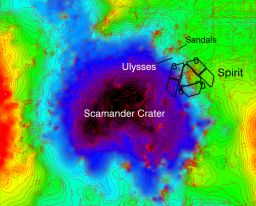 Topographic map of Spirit's location
Topographic map of Spirit's locationThis topographic map of Spirit's location at Troy represents low elevations in black, purple, and blue and high elevations in red. It was created with data from Spirit's camera images of the location, taken before it got mired at Troy. The topographic model has had a regional slope removed, which reveals that the rover's left wheels are sitting inside a subtle depression that the team has named Scamander crater. The right-side wheels are outside the depression.It has moved about a foot backwards since this map was configured. Credit: NASA / JPL-Caltech / Ohio State University
At some point in mid-March, if everything happened the way it was supposed to happen, Spirit experienced a low-power fault, turned off all her sub-systems, including communications, and went into a deep sleep or hibernation.
That is exactly what the robot was programmed to do when the going got too cold and power dropped for sustained periods of time below levels needed to wake up and carry out even simple tasks. Those levels turned out to be around 130-135 watt-hours. Since late March, the rover ostensibly has been using available sunlight to recharge her two main power batteries and keep her clock going.
Once her batteries recover a sufficient state of charge, Spirit is programmed to wake-up and phone home. The general consensus among team members is that the rover will reach out and make contact sometime in the September-to-November timeframe, with some engineers laying best odds on October.
The team has been listening for a beep from Spirit at pre-determined times every day through the Deep Space Network (DSN), and at specified times weekly during Mars Odyssey passes for the last couple of months just in case the rover wakes up earlier than expected.
In recent weeks however, updated models indicate that Spirit might have lost so much power that the mission clock stopped, tripped the fault, and the rover lost track of time. If this has happened, then the rover will sleep in, until her batteries have recharged sufficiently and there is enough sunlight on the solar arrays to wake her up. But models are models, there’s margin for error, and no one can know for sure if Spirit lost the mission clock or not.
“There’s a lot of buzz about it, but no facts that it’s happened,” Arvidson said.
Callas puts the chances at 50-50. That’s good enough, he said, to at least try and ring the alarm for the rover. So this week the MER engineers began a procedure they call ‘sweep and beep’ to actively try to wake up Spirit. “This is a necessary step, if the rover has experienced a mission clock fault, because it means the rover would be listening only during a narrow 20-minute period every hour it’s awake, said Callas. “And, we wouldn’t get an active transmission from the rover in that case, so we‘re sending something to the rover to get it to respond, to wake up.”
 Simulation of Spirit's sandy situation
Simulation of Spirit's sandy situationThis artistic image -- in which Astro0 has placed a two-dimensional MER into a scene created by pictures taken by the real rover -- illustrates Spirit's predicament at the location in Gusev Crater known as Troy. Although the angles are admittedly a little off and the disturbed soil isn't quite right, it offers the casual reader a glimpse into the present scene on Mars -- and this rover scribe thinks it's a pretty cool illustration.Credit: NASA / JPL-Caltech / ©Astro0 2009
Putting sweep and beep into action has kept Spirit’s engineers busy, developing the strategy, vetting it with the team, building the commands, and making sure all proper checks have been made. “We’re now in the implementation phase of that new strategy,” said Callas.
The MER team does not anticipate hearing back from Spirit at this point. “We would expect we would need more sunlight on Mars, so it will be more likely we’ll hear from the rover as we go on,” Callas said. “But we want to start [reaching out] now because we want to make sure we’re covering this early period [of possible communication]. And we want to make sure we get everything worked out and make sure the team is consistently radiating these commands to the vehicle.”
Despite the brutal cold of this Martian winter, it’s not really about temperature for Spirit right now, but energy, Callas said. “Remember, the daily temperature change is greater than the seasonal temperature change, in that you get 100 degrees Celsius swing each day on Mars. There’s a big difference between air temperature, ground temperature, or sky temperature,” he said. In fact, five feet makes a difference on Mars.
Consider this: the temperature where Spirit’s wheels are is different than the temperature where her Pancam is positioned. Imagine summer at your head and winter at your feet.
“For this rover right now, it’s about energy, and how much sunlight she’s getting,” Callas continued. “We’ve passed winter solstice and the Sun is higher in the sky. We know that. We know geometrically that there is more sunlight falling on the arrays now than there was at the depth of winter.” The unknown factors, he added, include the amount of dust that has accumulated on Spirit’s solar arrays, how much sunlight Spirit is able to take into her arrays and how much power she can generate.
“I think everybody is hoping to see this rover come back, and we have some basis for that,” said Nelson. “Spirit has survived past winters, although admittedly it hasn’t gotten quite this cold. But even with the estimated low power, one of the first things we do with the energy we do have is keep some of the primary, survival heaters going. So while it may not have enough energy to keep those heaters on full blast through the entire night, it is believed that the rover is not going to go completely down to ambient. In other words, we estimate that Spirit went down right to the allowable flight temperature or A-F-T. The REM’s AFT is -40 Celsius, but most other components are tested to -55 C, and then we have some mostly mechanical components that are good to lower temperatures, like motors, some of which have tested down to -110 C.”
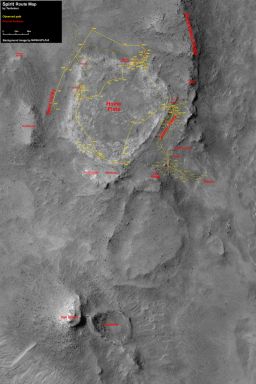 Spirit route map
Spirit route mapThis image taken by the HiRISE camera onboard MRO has been labeled by Eduardo Tesheiner, an active participant on UnmannedSpaceflight.com, to show Spirit's route from its arrival in the Home Plate area on Sol 743 through Sol 1871 (April 8, 2009), when the rover began suffering a series of bouts with 'amnesia.'By May 2009, the rover was mobility impaired, stuck in a sandy pit on the edge of a shallow crater. It is there now, hunkered down and waiting for the chill of winter to pass. Credit: NASA / University of Arizona / Eduardo Tesheiner
This month, Opportunity internal REM temperature was registering “between 10 and 15 degrees warmer” than at the depth of the winter, form about -39 C to now around -26 C, said Nelson. The engineers believe that Spirit is, likewise, warming up, “though the swing may be a little wider,” Nelson added.
Yesterday’s press release from NASA headquarters was less optimistic, perhaps in line with the under-promise/over deliver strategy so popular in Washington and bureaucracies these days. If the Spirit has not responded by March 2011, the release stated “it is unlikely that we will ever hear from it.”
That March 2011 date was chosen because of calculations, based on numbers from the past three Martian winters, indicating February as effectively the latest month the rover will experience a spring-cleaning event following winter, Nelson explained. “But that’s only three samples and there is a lot of uncertainty in that estimated,” he pointed out. And as everyone following this mission knows, the safest bet is never say never with these intrepid robots.
Time, as always, will tell. Of course they won’t live forever and Spirit has clearly been challenged this winter in a way no robot ever has before. “The rovers were never designed for this kind of environment and we’ve never experienced a low power fault on a rover or a mission clock fault on the rovers,” Callas reminded.
Still, the MER team remains buoyed by confidence and a deep-down belief that Spirit will be back in action sometime in the coming months. “Right now, I remain fairly optimistic,” Nelson confirmed. “If we did not go into the mission clock fault, our projections are the earliest we might hear from Spirit around mid-August to mid-October is most likely. If we’re in mission clock fault, we’re still doing some calculations on that, but probably toward the latter part of that timeframe, probably October and into 2011, would be when we expect to hear in the mission clock fault scenario. And we would have had to provoke a beep from her with our sweep and beep strategy.”
Whether Spirit’s ‘beep’ comes sooner or later, Callas said, “we’ll be ready.”
Opportunity from Meridiani Planum
Opportunity drove into July on Sol 2288 (July 1, 2010). Producing a moderate amount of energy, around 350 watt-hours of power, the rover made tracks for some 71 meters (233 feet) in a simple zigzag pattern to the east. Then, during the long July 4th / Independence Day weekend, the rover collected an atmospheric argon measurement with her alpha particle X-ray spectrometer (APXS), and performed two more tests with her new AEGIS autonomous pointing software, covered in the March 2010 MER Update.
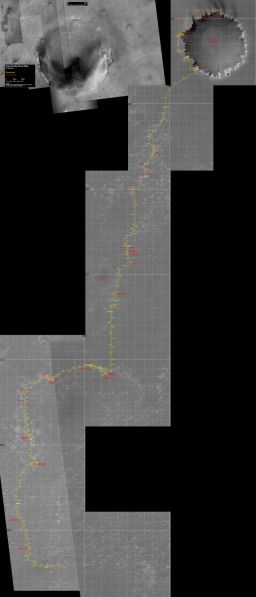 Opportunity route map, part 1
Opportunity route map, part 1The presentation here of Opportunity's route map has expanded into two parts. As Eduardo Tesheiner, who creates these, puts it: "Since the start of the east drive, the route plot was quickly reaching the right end of the background map, so it was time to add another 1km x 1km square to the map. This map was already really big and unfortunately it became too big to manage it as a single picture on my PC, so it's time to move on to a new image." See next picture below. Credit: NASA / JPL-Caltech / UA / Eduardo Tesheiner Credit: NASA / JPL-Caltech / UA / Eduardo Tesheiner
AEGIS is, basically, a pattern-recognition ‘intelligence’ that enables the rover to seek out and quickly find rock targets from a distance, based on albedo, or brightness, and shape, and determine whether or not they’re worth stopping to check out more thoroughly. “It’s really a feet-forward experiment in automated pattern recognition,” said Arvidson. “They’re adjusting the parameters as we go and using Opportunity as a kind of guinea pig -- and it seems to be working well.”
By Sol 2293 (July 6, 2010), Opportunity was ready to roll on. She took off heading east again, ripping another 71 meters (233 feet) under slightly hazy skies, with the atmospheric opacity or tau registering 0.22.
After a sol’s rest, Opportunity cruised onward, into the second week of the month, putting another 68 meters (223 feet) behind it on Sol 2295 (July 8, 2010). The rover then spent her three-day weekend studying a ripple, Juneau, and investigating the under-surface composition, Juneau Road Cut, where the rover did a turn-in-place to churn up the soil. She collected both microscopic imager (MI) pictures and APXS data to get a good look inside the ripple.
At some point that Sunday, on Sol 2298 (July 11, 2010), Mars smiled down on Opportunity, sending a gust of wind that cleared much of the accumulated dust on the rover’s solar panels. It proved to be a cleaning event that caused the rover’s energy production to jump by more than 10%, to levels above 400 watt-hours.
With that nice little bump in power, Opportunity was able to drive out that week with back-to-back jaunts on Sols 2299 and 2300 (July 12 and 14, 2010), each more than 70 meters (230 feet). As the sols passed, the rover’s energy production increased to 492 watt-hours, and she seemed raring to go. But as the rover came to a stop after driving on Sol 2300, the Mars Odyssey orbiter put itself into a safe standby mode, so planned Ultra-High Frequency (UHF) downlink passes were cancelled.
 Opportunity route map, part 2
Opportunity route map, part 2This new, second picture or add-on to the Opportunity route map above covers the territory Opportunity traversedon its 'east drive' to Santa Maria. The rover has driven a couple hundred more meters this month. Credit: NASA / JPL-Caltech / UA / Eduardo Tesheiner
Rover engineers changed all available X-band passes, normally uplink only, to two-way communications. Since the supportable downlink data rates for these passes are low, the rover was instructed to send only basic engineering telemetry, including health updates, down to Earth. Up on Mars, Opportunity effectively stood down as almost all science activities were put on hold.
“For a week and a few days, we were doing direct-to-Earth and direct-from-Earth communications with the rover’s high gain antenna (HGA), which meant that we couldn’t drive and we couldn’t collect much data,” said Arvidson. “Basically, we were just getting health data.”
Of course the team did schedule an MRO downlink as soon as Odyssey went into safe mode, he added. But by the time that downlink slot came around, Odyssey was back and the MER team had ramped back up to “normal operations,” Arvidson said.
As Opportunity’s luck would have it, there was a little excitement during the downtime. A drive that had been designed based on Sol 2300 (July 14, 2010) data was uplinked and executed on Sol 2301 (July 15, 2010). The telemetry returned indicated that the rover completed the 70-meter (230-foot) drive without incident.
Then, right after that, the rover captured a picture of its very first dust devil with its panoramic camera (Pancam). It appeared as a tall column of swirling dust in a routine image the rover took in the drive direction, east-southeastward, for use in planning the next drive. But it was another first for the rover and the mission.
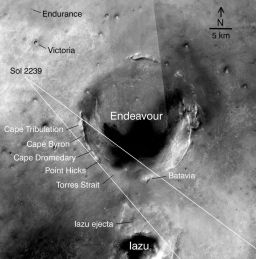 Ports at Endeavour
Ports at EndeavourRay Arvidson and crew at Washington University St. Louis labeled this map of the region around Opportunity to show the relative locations of several craters and the rover's location in May 2010. That's when the rover took the pictures for a super-resolution view of the horizon to its southeast. The base map here is a mosaic of images from the Context Camera on NASA's Mars Reconnaissance Orbiter. The scale bar is 5 kilometers (3.1 miles).Credit: NASA / JPL-Caltech / Malin Space Science Systems / WUSTL
It’s hard to believe, but Opportunity had never seen a dust devil before this month, despite systematic searches in past years, and even though Spirit has seen dozens of dust devils at its location halfway around the planet.
Spirit's location inside Gusev Crater, though, is rougher in ground texture, and dustier, than the area where Opportunity is working in the Meridiani Planum region. Those factors at Gusev allow vortices of wind to form more readily and raise more dust compared to conditions at Meridiani, Lemmon explained.
Orbiters at Mars have photographed tracks left by dust devils near Opportunity, but they are scarcer than tracks seen near Spirit. If the swirling winds at Meridiani occur where there is no loose dust to disturb, however, they may be more common than visible signs of them would indicate.
The fact that Opportunity captured the dust devil just a sol or so after Martian wind cleared dust from her solar array could be "a coincidence,” Lemmon said. “But,” he added, “there could be a connection." In any case, the team planned to resume systematic checks for afternoon dust devils with Opportunity's navigation camera for the first time in about three years.
Seeing a dust devil on the plains of Meridiani was a pleasant surprise for the team. “Wow,” said Nelson. “That was really interesting. It means that the atmosphere is a little more active than we might have thought.”
The team is also hoping that maybe a gust of wind will clean off the some dust from the mirror on the miniature thermal emission spectrometer (Mini-TES), Nelson added. Last month, the Mini-TES caused a bit of distress for the team. The mineral-seeking spectrometer failed to communicate with the rover when powered on during the Sol 2257 (May 30, 2010) plan and that resulted in an apparent fault on the Pancam mast assembly (PMA) that put life on hold for Opportunity at the top of June.
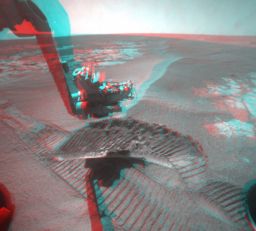 Checking out Juneau Road Cut in 3-D
Checking out Juneau Road Cut in 3-DOpportunity's prime directive is "drive, drive, drive," as Steve Squyres, principal investigator for rover science puts it. But the rover took a little time this month to stop and smell the sand and check out a ripple the team dubbed Juneau. Here, in this 3-D image assembled by Stuart Atkinson, the rover is checking out the under-surface soil in a spot called Juneau Road Cut. For more interesting images and MER poetry, check out Atkinson's "Road to Endeavour" blog at: http://roadtoendeavour.wordpress.com/
Credit: NASA / JPL-Caltech /S. Atkinson
“We are currently investigating whether the problem is in the Mini-TES instrument or in interfaces with the rover,” reported Amy Trueba Knudson earlier this month. Knudson, of Arizona State University (ASU), oversees the science for Opportunity’s Mini-TES. “We are also trying to determine whether it is safe to turn Mini-TES on again to test again,” she said. “In short, the investigation is proceeding, but the future of Mini-TES remains unknown. We are continuing to open and close the Mini-TES mirror shroud in the hopes of clearing off dust in the interim,” she confirmed.
The Odyssey team, meanwhile, investigated and was implementing careful steps designed to resume the orbiter's science and relay operations with Opportunity. Engineers found the cause of the orbiter’s safe-mode entry to be the spacecraft's proper response to unexpected performance by an electronic encoder that controls a gimbal responsible for rearranging the solar array that produces the energy the orbiter uses. According to mission specialists, tests indicated the problem lies with the encoder itself. Odyssey switched to a redundant encoder, and there has been no subsequent sign of any mechanical problem with the gimbal. Engineers then sent commands for Odyssey to switch back to using its high-gain antenna (HGA). By July 23, Odyssey was completely back on track and relay communications from Opportunity resumed.
On Sol 2310 (July 24, 2010), Opportunity, her odometer at 21,830 meters (21.83 kilometers, or 13.56 miles), took off on a “special” drive, as Arvidson put it. It was a test of a backward hazard avoidance strategy, discussed in last month’s MER Update.
“The challenge with driving backward is we have the low gain antenna (LGA) coming up from the deck blocking some of the field of view of the navigation cameras, so when you’re taking images, you have that in the way,” Callas explained. “The rover drivers have developed a technique where they get the rover to arc one way, and then the other way taking images so you can see the terrain that would otherwise be blocked by the LGA and the Pancam mast assembly.”
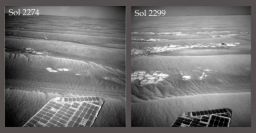 Mr. Martian Clean
Mr. Martian CleanCleans like a red tornado. These images show how dusty Opportunity's solar panels were last month, in mid-June 2010, and then what they looked like after a gust of Martian cleared the dust this month. The comparison arrives here courtesy of Stuart Atkinson.Credit: NASA / JPL-Caltech
“We tried it out and it worked great,” said Arvidson. That means Opportunity can now conduct autonomous driving or drive on its own backwards.
This rover has been driving mostly backwards this year because the actuator or motor for its right front wheel continues to draw slightly more power than the other five wheels when driving longer distances, a possible symptom the may precede the actuator’s failure. So the rover drivers have instructed the rover to drive backward to ease the arthritic wheel and to take rests along the way, hard as that can be for the scientists sometimes who are almost salivating over what awaits them at Endevour.
Opportunity made a pit stop this weekend to check out a large patch of bedrock, for the ongoing campaign to sample bedrock and soil between Victoria Crater and Endeavour Crater. “We just finished a 15-16 meter drive that put us on bedrock to check the way the geology has changed,” said Nelson Friday. “The plan is to put the APXS down and integrate over the weekend. We may plan some other instruments on Monday, probably the Mössbauer.”
“We haven’t done APXS measurements on rocks since Chocolate Hills back in Concepción,” noted Arvidson. “The last IDD work was on Juneau earlier this month, but we haven’t done actual rock for a long time, because we’ve been busting on the way to Endeavour.”
 On solid ground
On solid groundAfter weeks and weeks of roving through fields of ripples, Opportunity pulled up this weekend onto some bedrock to check it out. This image, processed by Stuart Atkinson, arrived just before the rover stood down for a week or so because of Mars Odyssey putting itself into safe mode.
Credit: NASA / JPL-Caltech / Cornell
With Endeavour Crater now visible in the distance, the scientists just can’t wait to get there. “We’re about 11,000 meters, 11 kilometers, from Cape York, which is the probable landfall onto Endeavour,” said Arvidson.
“It’s interesting, because, from what we can see in Compact Reconnaissance Imaging Spectrometer for Mars (CRISM) images from MRO, it’s surrounded by sedimentary layered rocks that show -- for the first time anywhere Opportunity’s been -- hydrated or water-bearing mineral exposed on the surface. That’s about 300 meters in extent to the west of the rim. Then, of course, the rim has what we think from CRISM are clay minerals exposed. So we are anxious to get there,” he said.
That means “drive, drive, drive,” as Squyres has so often said, remains Opportunity’s prime directive.
“Since we do want to characterize the rocks and soil along the way, we will make several stops during the next 11 kilometers for rock measurements, and one or two stops for soil measurements with the [instruments on] the IDD" [instrument deployment device], said Arvidson.
Although Opportunity still has a long, long way to go, the road ahead is inviting and the rover is past the worst of the ripples now. "We did the kind of counter clockwise loop around the big ripples and we’re pretty much driving on a heading of 110-degrees relative clockwise from north,” Arvidson elaborated. “That is just about east, a little bit south of east. We’ll make a few zig-zags in coming weeks, but we’re going into terrain that is harder, with a higher thermal inertia, so there will be better traction and less sinkage.”
Despite all the incoming Pancam pictures of Endeavour’s rim, Opportunity is still not able to see exactly where it will make ‘landfall.’ “We won’t be able to see Cape York until we get within a couple of kilometers of Endeavour,” said Arvidson. “But we know where it is. We know it’s there.”
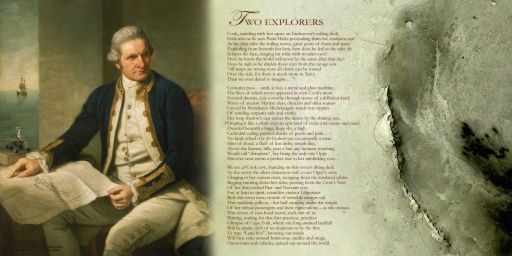
Two Explorers
Two Explorers: A Downloadable MER Poemster
MER poet Stuart Atkinson and artist Asro0/Glen Nagle, both of UnmannedSpaceflight.com, joined forces once again to present another in what should become a series of MER "poemsters.'
Credit: NASA / JPL-Caltech / Cornell / Maas Digital / Cook image by Nathaniel Dance, NMM London /poetry by Stuart Atkinson / artistic composition by Glen Nagle
Support our core enterprises
Your support powers our mission to explore worlds, find life, and defend Earth. You make all the difference when you make a gift. Give today!
Donate

 Explore Worlds
Explore Worlds Find Life
Find Life Defend Earth
Defend Earth


